 I am extensively quoted in this article from Entrepreneur Magazine.
I am extensively quoted in this article from Entrepreneur Magazine.
Practice: Mindful Browsing
The holiday season certainly has its stresses. Big family gatherings, the planning of meals and events, traveling, while juggling work responsibilities at the same time, can all take their toll. One thing that can certainly cause discomfort is the pressure to consume – and the tendency within the stresses of the holidays to consume more than we need. One thing mindfulness practice can do is to make us aware of our habits – our habits of relating to stressful situations, people, the types of thoughts we like to indulge in, and our habits around consuming. Sometimes we consume things not because we need them but because of an urge. And sometimes that urge is based on deep-seated emotional tendencies that are often unconscious.
Here’s a practice I call mindful browsing that can help us pause and create more spaciousness in our experience of being consumers. It’s important to remember, though, that maintaining your daily meditation practice during the holidays is a vital support for a practice like this. When you do this practice, please don’t judge yourself. Just notice what your experience is in any given moment. Be curious about your patterns around consuming, but not self-critical. Hold it all with a kind awareness.

When shopping for food or other things, and you feel the urge to buy, try doing some mindful browsing. Take a period of time, from a minute to 10 minutes or whatever, and just look at what you are desiring without purchasing it. Just allow yourself to feel the sense of wanting – the hunger in your stomach, the desire for something fancy, the deliciousness of the food or the style points of the clothing, etc. Make a self-inquiry like this: Is this thing I am wanting going to make me happy? Also notice your intention: Is this thing I am wanting actually going to nourish me, or do I just want it out of habit? Am I just reacting out of a sense of restlessness, boredom, fear, anxiety? Allow your hunger for whatever it is to be held in awareness. After taking such a pause, you may discover that the desire for that thing has either changed or disappeared entirely. Either way, you’ll have a greater sense of choice and freedom in making your purchasing decision.
Mindfulness Has 24/7 Potential
So many people have told me over the years that when life gets hard, sitting and meditating and being mindful is even harder. Yet it is precisely during times of stress, discomfort, disappointment and confusion that mindfulness can help us the most. Having worked with a few thousand people at this point, I have come to see patterns in the way people avoid practice. When I ask people why they couldn’t meditate, they say things like, “Oh, I wasn’t relaxed enough to meditate,” or, “I wasn’t feeling happy,” or, “I was too overwhelmed.” These statements all reveal a misconception about mindfulness: that we’re supposed to do it only under conducive conditions, when we feel like it.

But the point of mindfulness is not to feel good, or to relax, or to feel calm. It is to meet our lives exactly as they are in any moment. Let’s face it: life is messy. It doesn’t operate according to our plans and good intentions. Things happen. We experience pain, both physical and mental, as well as uncertainty, ambiguity, fear, loss, praise and blame. Many of the moments of our lives are not “conducive” to peace and relaxation. Yet the invitation of mindfulness is to find our way into any situation with greater presence, focus, kindness and wisdom. In order to do this we have to practice. We have to practice every day, even if for only ten minutes. If you are in a state of despair, sit with it for 10 minutes and see what happens. Even if you spend the entire 10 minutes rocking and moaning and seething, your relationship to your despair will begin to change if you sit with it enough.
Once some years ago I rented a cabin in the Santa Cruz Mountains for a solo retreat. My plan was to spend three days in silent meditation and then return to my life in San Francisco. I arrived at the cabin in the early afternoon, unpacked my things, set up my meditation space, made a cup of tea, and then, around 4 o’clock, sat on my bench for my first session of practice. Within a few minutes I began to feel a deep sadness somewhere beneath my ribs. Soon, tears began trickling down my cheeks. When my body started to shake with sobs, I knew that this was no ordinary sadness. I fell off my bench, sobbing uncontrollably, completely crushed and shattered. As the intense wave passed, I steadied myself and sat upright on my bench again. I continued to weep, and then another violent wave shook me and I fell off my bench again, on the floor, shattered anew. When that wave passed, I sat up again, re-established my posture, and continued my practice. It went on for an hour like this. I found that as each wave of grief subsided, I could re-establish my posture and the holding of the experience in my awareness. At the end of the hour, I got up from my bench, dried my cheeks, and assessed things. I felt good, cleaned out, whole, at peace. In that moment I knew that my retreat was over.
I spent the night in the cabin, and in the morning packed my things and returned 2 days early. My sobbing session on the bench wasn’t pretty, it certainly didn’t look like meditation – but my willingness to meet the messiness inside my own heart is what allowed me to come to a deeper clarity and understanding. Mindfulness, like life itself, takes many forms.
5 Excuses Not to Meditate – & 5 Reasons to Do It Anyway
A nice infographic from the folks at Mindful magazine.
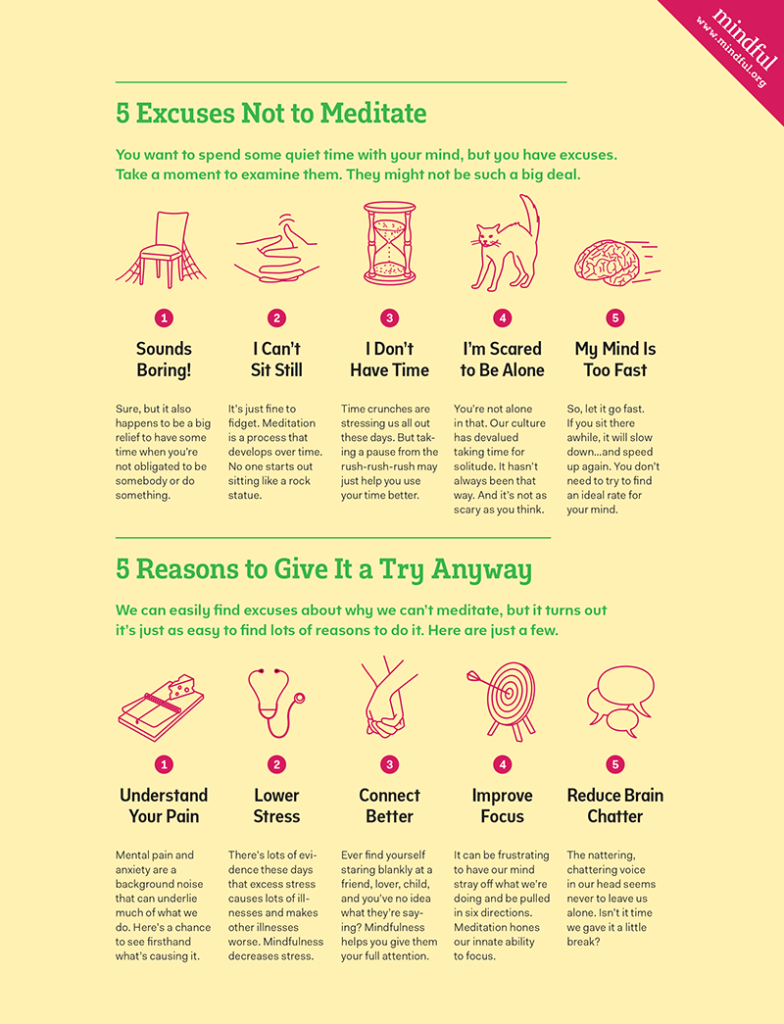
Mindfulness May Decrease Racial Bias
A new study out of Central Michigan University suggests that mindfulness training can decrease bias based on race and age. Mindfulness is a skill that anyone can learn, including police officers, and it may prove to be an important component in the future of diversity training.
A story on the study can be found here. http://www.yesmagazine.org/peace-justice/study-shows-mindful-meditation-helps-reduce-racial-bias-20150806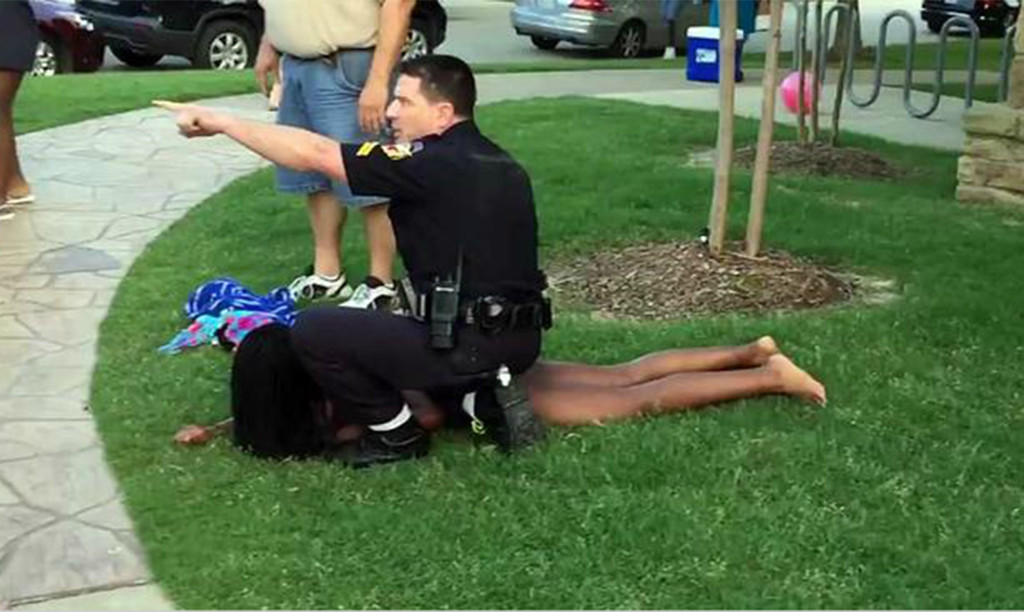
In Relationship to Suffering

Mindfulness has been associated with so many positive things – greater focus, clarity, joy, compassion, emotional balance, resilience, general well-being, and decreased stress, to name just a few – that it’s easy to ignore one of its primary purposes. Mindfulness is essentially a practice of moving towards suffering, of coming into relationship with the challenges, traumas, anxieties and stresses, both large and small, of our lives. Because suffering is an unavoidable fact for every human being, the way we relate to it is critically important.
The moment we sit down to meditate, we force ourselves to be aware of the thoughts, stories, and emotional patterns that drive us most of the time. Many of these patterns are habitual, unconscious, obsessive, and negative. Yet they set the tone for how we respond to events. When we sit down to meditate, we also become aware of the places in the body that are tight, registering tension, or wounded. Because we are so driven by our to-do lists, our non-stop busyness makes it easy to avoid our difficulties, and to avoid our bodies and the stress signals they give us. But that avoidance conditions us to think that our difficulties are mistakes – rather than something we can be in relationship to.
Mindfulness teaches us that rather than avoiding suffering, we need to move toward it, with openness, courage, and curiosity. We become intimate with our suffering not to fix it or change it but to know it fully, to see how it effects our life. When we hang out with our fears, wounds and anxieties without needing to fix them, we bring their energy into consciousness in a way that brings us healing. We clearly see the effect that our habitual thoughts and emotional patterns have on us. We see the suffering that our minds continually create, and we see the tension and stress in our bodies as a form of that suffering. When we see these patterns over and over again through daily meditation, over weeks, months, and years, our perspective changes. Rather then believing our stories, we see that they are just mental events that don’t have to control us.
As a result of this regular intimacy with our pain, we become more whole as a result, and more free. And we start to think and act in ways that reflect that wholeness. You may not learn this in the next magazine article on mindfulness you read – but it takes courage to be mindful. Because facing our suffering is quite challenging, and also quite necessary for a fully lived life.
Not Retreating from Life
 I recently returned from a 9-day intensive meditation retreat focused on the practices of concentration and mindfulness. The first four days of the retreat presented me with the usual struggle – re-learning how to slow down, quitting caffeine, abandoning cell phones, blogs and the internet, and mostly, just watching the habit patterns of my mind replay themselves ad nauseum. By day five I was really settling in nicely, my mind was calmer, clearer, and more focused, and I was able to steady my attention on the breath – and even more interestingly to me – the stillness of knowing the breath. I was really beginning to hit my stride and was looking forward to deepening my concentration in the following final days of the retreat. But on Sunday night, instead of listening to that night’s talk on practice with my fellow practitioners, I found myself in the emergency room of the nearest hospital with an IV drip of saline in my arm.
I recently returned from a 9-day intensive meditation retreat focused on the practices of concentration and mindfulness. The first four days of the retreat presented me with the usual struggle – re-learning how to slow down, quitting caffeine, abandoning cell phones, blogs and the internet, and mostly, just watching the habit patterns of my mind replay themselves ad nauseum. By day five I was really settling in nicely, my mind was calmer, clearer, and more focused, and I was able to steady my attention on the breath – and even more interestingly to me – the stillness of knowing the breath. I was really beginning to hit my stride and was looking forward to deepening my concentration in the following final days of the retreat. But on Sunday night, instead of listening to that night’s talk on practice with my fellow practitioners, I found myself in the emergency room of the nearest hospital with an IV drip of saline in my arm.
I would later find out that I had heat exhaustion. That Sunday the temperature had reached 105. The day before when it was 95 I noticed that my steps were a little unsteady, and that I was slightly light-headed. I did not understand what these symptoms might mean. I felt great otherwise and thought I was drinking plenty of water. (Later I learned that I was drinking far too little water, and even if you do walking meditation in the shade, the intensity of that heat leeches the water and electrolytes right out of you.) So that Sunday night, my body began speaking to me more loudly, and I finally had no choice but to heed its message. A kindly person from the retreat center drove me to the hospital and waited with me as I lay on a gurney in the emergency room and they triaged me, monitored my vital signs, and did blood tests. I lay there for more than two hours before anyone told me what was wrong with me. I had no choice but to allow the experience to be just as it was; no point to resist what was happening. My body was the boss, and so my mind, pliable and at ease because of five days of concentration, relaxed and let things unfold. So I lay there the whole time watching the rising and falling of my chest. On the other side of the curtain on my left a man was in the process of passing away. I witnessed the doctor explain the nature of a “devastating injury” to the man’s family. Down the hall to my right, another man may have been dying as well (we never found out for sure) and doing it very loudly, with lots of screaming and pain. The screaming went on for about a half hour. And then there was a chilling silence. In the meantime emergency room nurses, doctors and technicians rushed back and forth, doing the best they could. As I lay there I understood then that I was in the midst of life. Or, as they say in Zen, in the midst of the great matter of birth and death. The gurney was now my practice cushion.
When I learned that I had heat exhaustion, was stable, and could go, I rose from the gurney as if a stranger in a strange land, filled with gratitude and sadness. Later, back on retreat, I reminded myself that you never get the retreat experience you want – maybe not even the one you need. When you go on retreat, birth and death do not stop happening, they just change their form. If anything, being on retreat is really just a way of experiencing life more directly, with more intensity. Retreat is just one form that life takes – but wherever you are, life doesn’t stop being life. It never does.
Great is the matter of birth and death,
All is impermanent, quickly passing.
Awake! Awake!
Don’t waste this life.
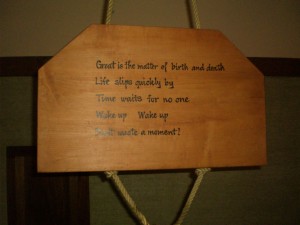
The Meditating Brain
This is a great graphic from an article in Scientific American showing the different regions of the brain that light up during the different phases of the meditative process. From focused attention, to mind wandering, to awareness of wandering and redirecting of attention.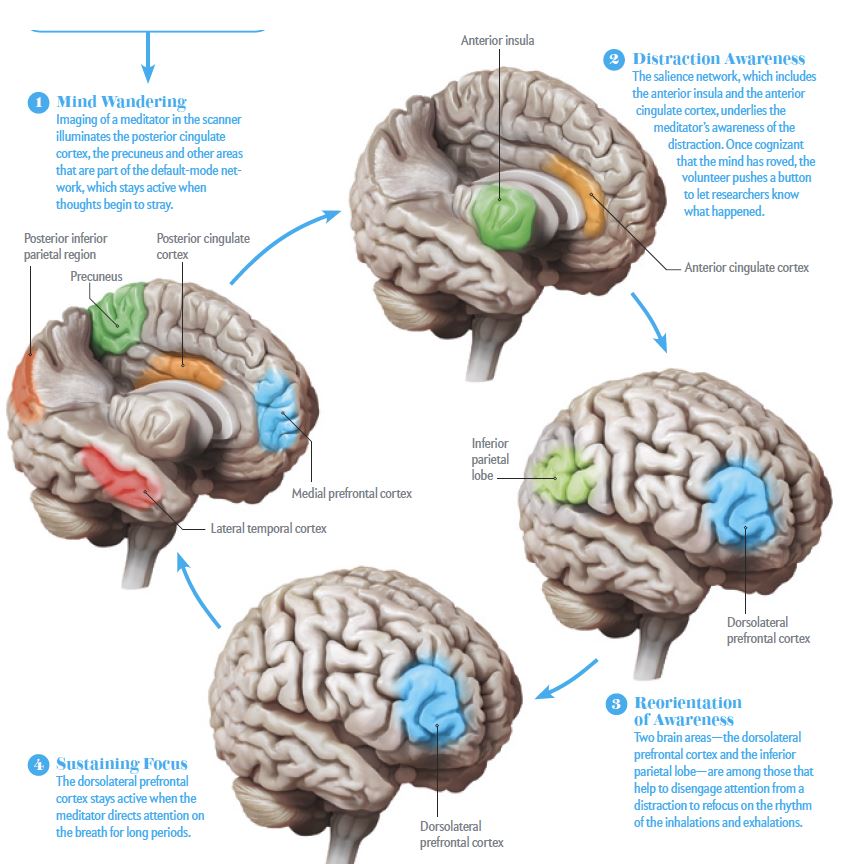
Work Life Balance is an Activity, Not an Event
Seeking Perfection in the Midst of Change
“Work Life Balance” is a popular theme in today’s always on and information-loaded workplaces. We are told that work and personal life are two powerful forces that we should strive to bring into balance with each other. As if work life balance were an external goal that can be realized if only we balance the scales properly. But life is always changing. Our jobs change, our colleagues change, the economy changes, industrial conditions change, our bodies change, our minds change, our families and friends change, the world changes….Is there anything in life that doesn’t change? And because conditions are always in flux, we will always need to make changes to our own personal scales of work life balance.
An Inner Equilibrium
Instead of thinking of work life balance as an external state to achieve, it may be more useful to think of it as an inner equilibrium that we can cultivate every moment we are alive. Like a tightrope walker who is constantly making micro-adjustments to keep from falling, work life balance becomes an ordinary activity that we can do all the time to make sure that we are living our lives sustainably.
To Understand What is Needed
An example of work life balance may be something as simple as remembering to notice your breath during a meeting, or turning off notifications on your smartphone when you get home from work, or driving to work without the radio on to build greater focus while you commute, or consciously choosing to say no to that event invite that is just one too many, or remembering to call old friends you’ve been wanting to catch up with, or deciding to put your work down and go for a walk. Above all, work life balance is about being sensitive enough in each moment to understand what is truly needed.
How Mindfulness is Short Changed in Popular Culture
The glib and tongue and cheek video from the BBC below is a good example of how mindfulness is being covered in the media. A lot of what is seen in this video is actually informative, but something is missing in its discussion of mindfulness which is also missing in other popular depictions of the practice. The typical way of presenting mindfulness is that it’s all about living in the now. As one of the subjects of the video says, a breath doesn’t take place in the past and it doesn’t take place in the future. A breath can only take place now. So mindfulness is about being aware in the present moment. But mindfulness is about more than awareness and the present moment. The sociologist in the video who criticizes mindfulness as a form of escapism likely doesn’t have a mindfulness practice himself; but he’s pointing to a flaw in how mindfulness is presented.
If mindfulness is just about being in the now, after all, how does that possibly help us deal with the practical challenges of living? Good question. The truth is that mindfulness has always been about two things: awareness and clear comprehension. Clear comprehension is a critical element in being mindful: it is our capacity to discern what is true in our direct experience, especially as it relates to suffering and freedom from suffering. When we are aware of our breath, we are not just aware of a featureless present moment, void of content; we are also aware of the patterns of our minds that cause us stress, panic, and pain. And because of this discerning aspect of mindfulness, the choices we make start changing in response to what we are learning about what causes suffering in our lives. Those new choices then start to change our lives in very practical ways. We see through old, unhealthy patterns and disidentify from them, thus giving ourselves freedom to choose a different course. Far from passive escapism, mindfulness is about choosing the appropriate response.
Like Clouds Passing
 The human mind is beautiful, but also dangerous. Our thoughts and emotions can be powerful drivers of our behavior. Since many of our mind-states are negative, our actions are often at the mercy of our thoughts. Gloomy and pessimistic thinking, long established from habit, creates rigid and stereotyped narratives psychologists have labeled cognitive distortions. You probably know some of these stories from your own experience. They often begin with, “I’ll never be good at this because,” or “I’ll never be loved because,” or “My pain will always be like this because,” etc. These stories become so familiar to us that they define who we think we are or can become. And the actions we take in the world reflect the limitations of this thinking.
The human mind is beautiful, but also dangerous. Our thoughts and emotions can be powerful drivers of our behavior. Since many of our mind-states are negative, our actions are often at the mercy of our thoughts. Gloomy and pessimistic thinking, long established from habit, creates rigid and stereotyped narratives psychologists have labeled cognitive distortions. You probably know some of these stories from your own experience. They often begin with, “I’ll never be good at this because,” or “I’ll never be loved because,” or “My pain will always be like this because,” etc. These stories become so familiar to us that they define who we think we are or can become. And the actions we take in the world reflect the limitations of this thinking.
But negative thinking itself isn’t the problem; it’s how we relate to our thinking that’s important.
One of the most powerful things about mindfulness practice is that it gives us the space to observe and witness the activity of our minds directly. With mindful awareness we see that thoughts come and go constantly, they can’t be held onto or controlled. We see that thoughts are not solid or fixed, that they are not our destiny, that they aren’t facts that force us to act, but are rather like clouds passing through the sky of awareness. With this perspective, which is cultivated through regular mindfulness practice, thoughts are seen to be ephemeral events in consciousness. When we see the impermanent nature of our thoughts, we begin to dis-identify with them. With this increased awareness, we have a choice about how we relate to our minds. And since thoughts and emotions drive much of our behavior, when we make the mindful choice to focus on thoughts that serve us instead of hurt us, our actions in the world will more likely be of benefit to ourselves and others.
Mindfulness and the Art of Giving Space
Talk: San Francisco Insight Meditation Community, May 24, 2015
Assessing a Mindfulness Teacher
Here’s a really good article from the Huffington Post about criteria for assessing a mindfulness teacher. I agree with all the author’s points and feel they are a good set of guidelines for determining whether or not to work with someone. One point I might add is whether or not the person attends regular intensive silent teacher-led retreats. Intensive practice is what really keeps mindfulness teachers learning and growing. I would say that at an absolute minimum, a teacher should attend at least one 7-day silent retreat a year.
http://www.huffingtonpost.com/deborah-schoeberlein/who-should-teach-mindfuln_b_7227540.html
The Suffering Equation
There’s an old expression in mindfulness circles: pain is inevitable, but suffering is optional. Life is inherently stressful and challenging, and we sensitive human beings are affected in many ways in body and mind by the daily slings and arrows of existence. Because there is pain in life, the way we relate to the pain is crucial. The following formula can help us sort out the difference between pain and suffering:
S=PxR
Where suffering (S) equals Pain (P) times Resistance (R). Pain is inevitable, but when we resist pain in our lives we cause more pain, because we experience the anguish and fear that comes when we deny and avoid what’s true. When we recognize our pain and allow it to be there, without resistance, we open to the possibility of responding to our pain in ways that ultimately bring healing.
What we teach when we teach Mindfulness
This New York Times article about mindfulness at the World Economic Forum in Davos gives more proof of the ascent of mindfulness in our culture. One worry I have is whether mindfulness can truly be taught while being totally divorced from ethical principles or the spiritual context from which it developed. (That spiritual context is the journey to enlightenment of the man known as the Buddha more than 2600 years ago.) Without that context, there is a danger that teaching mindfulness becomes only about achieving better performance and enjoying life more – certainly worthy goals – rather than its deeper purpose: to radically change our relationship to our own lives, and to provide insight into suffering, the causes of suffering, the possibility of the end of suffering, and the ways needed to achieve that end. Those of us who teach non-sectarian forms of mindfulness – like MBSR – must walk a fine line between our fidelity to dharmic principles and the need to provide powerful practices in an accessible format to people who are not interested in “religion.” For me the dharma context is always foremost when I teach MBSR, which I do in a rigorously non-religious way. It’s my dharma practice which informs my own understanding of the causes of suffering and its release. Therefore, when my dharma practice is strong, so is my teaching. My fear is that many people are now teaching mindfulness who do not have a strong connection to practice. The risk is that much potential dharma teaching will get lost in translation or even ignored, short-changing the students in the process. This might then lead to the “dumbing down” of mindfulness. Many people have contacted me recently asking, “How do I become a mindfulness teacher?” My answer to them is to devote yourself to practice first. Then, from the depths of that practice, let teaching call your name.
Giving Space to the Joys and Sorrows of Life
Mindfulness is a simple yet profound way of being that essentially realigns our priorities.
We are told that we need to constantly be achieving things in order to be happy and living a successful life. And because of the non-stop busyness that drives so much of our behavior, our to-do lists, and progress in achieving our goals and plans, are what we focus on. As a result we ignore the very common signposts of human experience that tell us we are sentient beings living on this earth. The momentary joy of smelling a flower or eating a delicious meal or witnessing the smile of a child rush by us barely appreciated, or maybe completely missed, because our attention was occupied by thoughts of our next meeting or a project we have at work. Or, we miss the subtle clues inside our body that tell us that we are feeling sad, or anxious, or angry, or ill, and emotions seeking to be known and held in awareness are denied and distracted so that we don’t feel them. And deep intuitions that might guide us through life’s changes and point us to new ways of being are never given a chance to flower in the felt sense of the body because we ignore our bodies most of the time.

When we practice mindfulness, this all begins to change. Mindfulness is not a state of mind, or a technique, or a philosophy even. It is simply the act of giving space to what we experience as warm-blooded human beings. We give space to the old fears of not being good enough that have obsessed us all our lives, we give space to the anger that smolders inside when someone slights us, we give space to the old griefs that still have much to teach us. Giving space means letting the experience rise into consciousness, and holding it. Not changing it or fixing it, just holding it, letting it live in the light of awareness. Sometimes the pain and suffering we hold in awareness needs to be held for a long time – but eventually, what we hold in awareness will change. Its negative charge will lessen, or, as the Tibetans say, it will “self-liberate.” When the painful thought or emotion releases it will also give up its wisdom to us so that we will learn from it. Giving space to these all too human experiences allows us to metabolize the joys and sorrows of being alive. And what we cook in the cauldron of practice, given enough time, becomes the feast of our life.
Happiness is a Skill That We Can Learn
The pursuit of happiness is an idea deeply embedded in the American psyche, stretching back to the Declaration of Independence. But the idea of happiness is often distorted in our culture. We are told that happiness is about getting things. The right job, the nicest home, the best car, the perfect partner, etc. Yet lasting happiness isn’t about these things. It’s about how we experience our lives internally; it’s about how we respond to the physical sensations, thoughts, and emotions of our daily existence. Mindfulness practice points to the very real possibility that happiness is a skill that can be trained. Whether we train ourselves in an 8-week class in mindfulness-based stress reduction, or in our daily sitting practice, opening to the experience of the present moment – no matter what it contains – allows us to digest experiences while letting go of the stories we tell about them. This capacity to allow things to be as they are leads to more ease, peace, balance, well-being, and a sense of the richness of our lives – surely qualities that we can include in any definition of happiness. 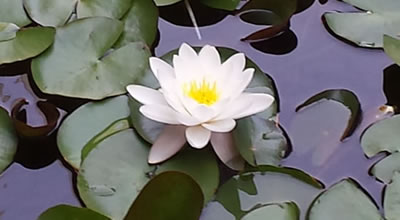
Why Mindfulness Will Survive the Backlash
An interesting piece from the Huffington Post. Apparently, 2015 is shaping up to be a year of backlash against mindfulness. But there’s no disputing the science.
“Despite the marketing of mindfulness as the latest hobby of the one percent, when it comes to the benefits of a meditation practice, the science is incontrovertible. A growing body of research unequivocally shows that a regular meditation practice is not only risk-free, but highly beneficial to the mind and body. Meditation has been shown to reduce symptoms of anxiety and depression, boost focus and improve sleep quality, among other benefits. And in just eight weeks, a meditation practice can create measurable brain changes in areas associated with memory, sense of self, empathy and stress.”
Full article is here.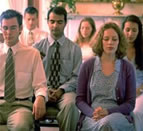
Meditation Helps Preserve the Brain
“A study from UCLA found that long-term meditators had better-preserved brains than non-meditators as they aged. Participants who’d been meditating for an average of 20 years had more grey matter volume throughout the brain — although older meditators still had some volume loss compared to younger meditators, it wasn’t as pronounced as the non-meditators.”
-Forbes Magazine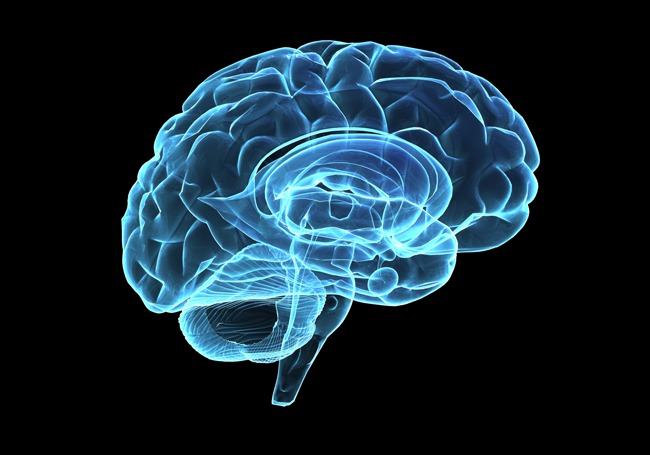
The Breeze at Dawn
|
The breeze at dawn has secrets to tell you.
Don’t go back to sleep. You must ask for what you really want. Don’t go back to sleep. People are moving back and forth across the doorsill where the two worlds touch. The door is round and open. Don’t go back to sleep. -Rumi
|
